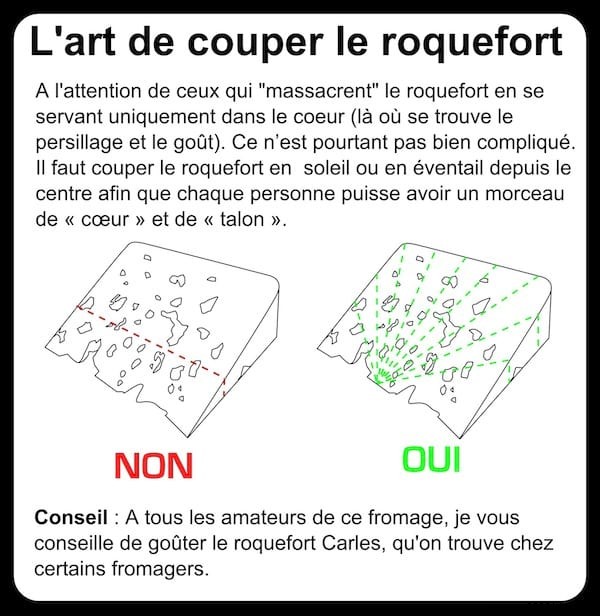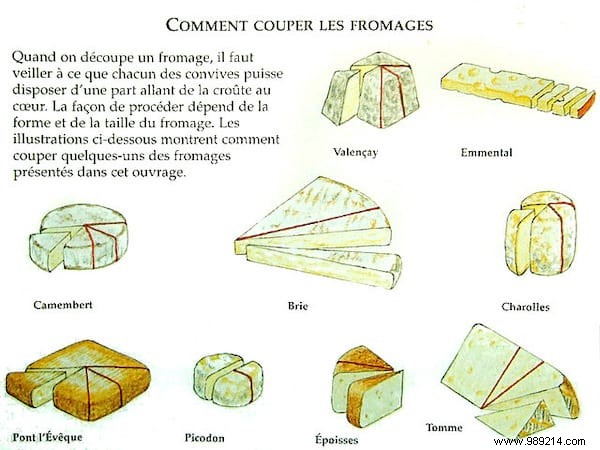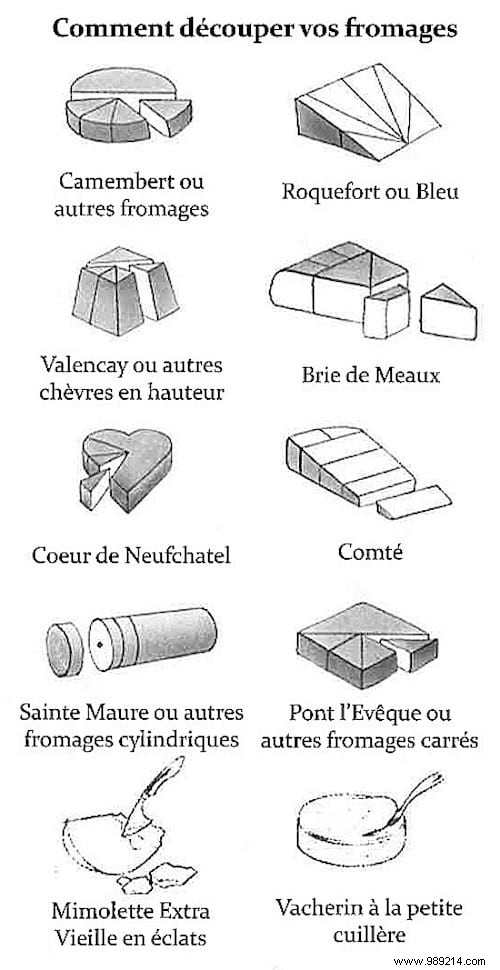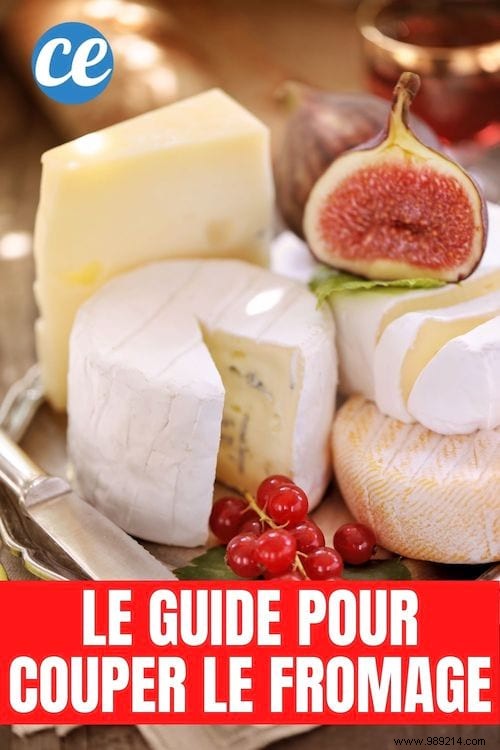
Bought a nice cheese platter?
But you don't know how to cut the cheese...
It's true that it's not easy because there are as many rules as there are cheeses!
And yes, you don't cut a Comté, a Roquefort or a Camembert in the same way.
Luckily, my cheese maker gave me his guide to cutting cheese like a pro . Watch:

And the basic rule is ultimately quite simple:you need an even cut between the heel and the dough.
Indeed, there is no way that a guest ends up with the whole cheese crust!
Here is how to properly cut the cheese (except for the raclette which is already cut) by type of cheese:
Round or oval cheeses are arguably the easiest type of cheese to cut.
To cut a round cheese, such as Camembert, Reblochon, Saint-Nectaire, Époisses or Coulommiers, it must first be cut in half.
Then we cut half in half to get 1/4 of the cheese and we cut the 1/4 in half to get 1/8 of the cheese.
There you go, it's already ready to be tasted!
This pyramid shape is the typical shape of some goat cheeses or Valençay.
The principle is the same as with a round cheese, but in height.
Concretely, the pyramid must be cut in two equal parts in the direction of the height, starting from one side to the other.
Then in each part, we cut 3 parts of the same size in the shape of a triangle.
This forms tall, thin slices.
The peculiarity of these cheeses is to have flavors concentrated in the marbling.
Indeed, the taste of the cheese is tastier in the green blue parts.
This is the case with Bleu d'Auvergne, Fourme d'Ambert, Roquefort...
It is therefore important that each guest can enjoy this type of cheese in the same way.
Cheeses cut in pieces such as Roquefort must be placed flat on the cheese board. Then it is cut into a fan.
Round-shaped cheeses, cut into discs, such as Fourme d'Ambert, are cut like a Camembert.

For square cheeses like Maroilles or Pont-l'Évêque, start cutting them in half diagonally.
We then obtain two triangles.
Then, each triangle is cut in half, then in half again and so on, depending on the size of the cheese.
Initially, these cheeses come in the form of a large wheel.
And we cut out pieces (like a pie), to present them on a cheese board.
This is particularly the case with Brie.
For these cheeses, slices are cut across the width starting at the tip.
When the portion is too large, as you move away from the tip, you can cut it in half at an angle to have two small portions in triangles.
Then when we get to the heel, we make length portions from the heel.
Comté, Salers and Morbier are some of these pressed cheeses.
They come in the form of narrow slices from millstones.
Start by cutting the heart into slices parallel to the crust.
Depending on the number of guests and the size of the cheese, these slices can be cut into two or three pieces.
We then obtain small rectangles.
Then when you reach half of the cheese, you cut the heel in the other direction or in a fan shape. It's an Aveyronnaise cut.
They are rarer, but this is particularly the shape of Neufchâtel.
And sometimes you find them on a cheese platter.
The principle is the same as for round cheese.
Cut the cheese in half lengthwise from the tip.
You get two halves that you cut in half, then in half again using a fan cut.

This shape is the typical shape of some goat cheeses.
Looks like small logs.
And it's very easy to cut these logs.
Just cut slices not too thick, like in a loaf.
Small round cheeses such as picodon are first cut in half...
...then each half is cut in half again.
The principle for cutting a slice in these high round cheeses, such as Charolles, is the same as for small round cheeses.
You have to cut the cylinder in half, then fan out equally sized portions in each half.
It is rare to present a whole tomme de brebis on a cheese platter!
In general, only a large slice is served.
To cut a piece, lay the slice on the larger side.
Cut the tomme in the middle widthwise.
Then fan out evenly.
This is notably the shape of a slice of Gruyere cheese.
The cutting of this cheese is really simple.
Just cut parallel slices across the width of the cheese.
Some cheeses have a paste so soft, even runny, that you cannot cut them with a knife.
We then serve with a tablespoon, after removing the crust with a knife.
If you have Vacherin, this is the way to go.
This is also the case of the Mont d'Or.
Conversely, some cheeses are so hard, such as old mimolette, that they cannot be cut!
The only solution is then to break them up to serve small pieces or make shavings with a peeler.
The monk's head is a special case, because it has to be cut with a chanterelle.

That's it, now you know how to cut all the cheeses :-)
It's not that complicated, is it?
Very practical for the end of year celebrations in France where cheese is essential on the menu!
The main thing is to ensure that each guest has a piece that goes from the crust to the heart of the cheese.
That way, no jealousy at the time of tasting!
- The cheese is cut with a knife washed in water then wiped (as for foie gras).
- You must put two cheese knives per cheese board:one for soft cheeses and one for strong cheeses.
- You can put labels on your cheeses so that your guests can easily identify the cheeses. It's easier to choose one!
- You can decorate your cheese board with peaks, pre-cut pieces, put a spoon in the runny cheese. The goal is to make it as appetizing as possible.
- If some of your cheeses only have a crust on one side, such as Comté, arrange the crust towards the center of the tray. For your guests, it's nicer to have the good side of the cheese in front of them... and easier to cut it.

Have you tried these grandma's tips for cutting cheese properly? Let us know in the comments if it worked for you. We can't wait to read you!